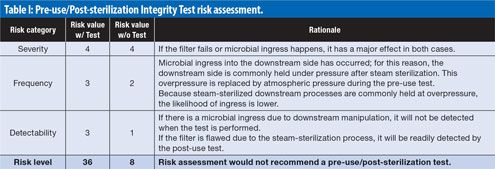Industry Perspectives and Practices on PUPSIT
PDA reviews an industry survey of concerns and best practices regarding the EU GMP’s required PUPSIT test for filters used in sterile filtration.
artmois/Shutterstock.com

This article was published in Pharmaceutical Technology Europe, Volume 30, Issue 6, June 2018.
Performance of a pre-use, post-sterilization integrity test (PUPSIT) is required by Section 113 of Annex 1 of Volume 4 of the EU GMPs and applies to the filtration of sterile medicinal products that cannot be sterilized in their final container (1). Sec. 113 states, “The integrity of the sterilized filter should be verified before use.” As written, the guidance indicates that integrity of the filters in question should be determined after sterilization but before use. One main argument made by the regulators in support of PUPSIT is the potential for the “blinding” of a flaw. The concern is that the presence of a flaw (i.e., one that compromised the functionality of the filter) would be hidden in post-use testing because product would have adhered to the breach and restored sterile filtration capability by blocking that route of egress/product flow, but not before potential contaminates could pass through.
Historically, however, many manufacturers of sterile medical products have justified not performing PUPSIT on the final product-sterilizing filter based on a patient-focused risk analysis. In these instances, it was determined that the risk of foregoing PUPSIT was less than the risk of negatively impacting the sterile filter performance via the integrity test. Following increased enforcement of Section 113 of Annex 1 by European regulatory agencies, manufacturers of sterile medical products are finding they must modify their manufacturing processes to incorporate PUPSIT and/or that they are not able to justify exclusion of PUPSIT on risk-based principles.
In response to member concerns, the Parenteral Drug Association (PDA) conducted a survey in March 2017 (2) to better understand the current state of sterile filtration operational practices and the implementation of PUPSIT among large pharmaceutical companies. The survey was open to PDA members with subject-matter expertise in PUPSIT and who held a manager-level position in biologic process development, manufacturing, validation, and/or quality.
Survey results
From the survey results, there seemed to be broad agreement on when and how to apply PUPSIT. Additionally, the results showed that companies performed PUPSIT commensurately as the development stage of the product in question progressed. PUPSIT was included in the pre-clinical material processes of about half the respondents, with an increase to 100% adherence to PUPSIT requirements through development Stages 1, 2, 3, and finally commercial manufacturing. While the respondents had the option to select either “Yes (always)” or “Yes (with exceptions)” as answers (wherein the combined Yes responses totaled 100%), Yes (with exceptions) outweighed Yes (always) by at least 2-to-1 in all cases.
The rationale behind the responses provided by the survey participants explained why some perform PUPSIT “with exceptions” rather than always. Members reported that some manufacturing sites use gamma-irradiated filters, and typically PUPSIT is not performed on this type of pre-sterilized filter. Other manufacturer sites determined via risk-assessment that performing PUPSIT created more risk than benefit to the process and end-product. A few respondents cited the issue wherein older facilities perform the integrity test off-line and do not have the capability of performing the integrity test in-line/in situ as required by PUPSIT.
Regardless of whether the participating companies performed PUPSIT always or with exceptions, there was 100% agreement from survey respondents that the ultimate decision of whether to perform PUPSIT should be left up to the end user. The reasoning behind this was that all respondents confirmed that the outcome of their company’s risk assessments regarding the implementation of PUPSIT resulted in greater risk to product sterility. This was accompanied by the assertion that the manufacturers understand their processes and products best and are hence the appropriate judge of how to reliably assure product quality and patient safety.
Table I from a PDA Pre-use/Post-sterilization Integrity Test Task Force commentary published in 2012 outlines a typical risk assessment regarding PUPSIT integration into manufacturing processes (3). The risk level was determined by multiplying the severity, frequency, and detection risk values together (higher numbers denote more risk). The analysis by the task force reflects the experiences and concerns of the survey participants and clearly shows the anticipated results if PUPSIT is introduced into a validated, well-controlled process.

In addition to the concerns regarding the integrity of the filter being compromised by PUPSIT itself, the survey also shed light on concerns regarding the mechanics performing PUPSIT in alignment with regulatory expectations. Although both diffusion/forward flow and bubble-point test methods were successfully employed by the respondents, concerns were shared regarding sufficiently wetting the filters prior to testing. Two main concerns were that the wetting fluid (product buffer or water) potentially dilutes the product and that single-use technologies make the required downstream volume of wetting fluid difficult to attain. One company reported that they had products where it appeared that the product-wetted bubble-point value was too high. However, when the filter was flushed with water and retested with the water bubble point, the filter was shown to be not compromised.
In summary, the survey points to a general trend of manufacturers relying on effective risk analysis to determine when and how PUPSIT should be incorporated into their manufacturing processes. Although the PUPSIT requirement will be enforced for the time being, it is the intent of the industry to eventually effect science-based changes to strict application of the practice. PDA and its members are working toward this end through open dialogue and sharing of information in the form of surveys such as the 2017 PDA PUPSIT Survey as well as public commentary and future research initiatives.
References
1. EC, EudraLex Volume 4: Good Manufacturing Practice Guidelines, “Annex 1, Manufacture of Sterile Medicinal Products” (Brussels, 2008).
2. PDA, PDA Research: 2017 PDA PUPSIT Survey (Parenteral Drug Association, January 2018).
3. PDA Pre Use/Post-Sterilization Integrity Test Task Force, PDA J. Pharm. Sci. and Tech. 66 (5) 394-395 (Sep.-Oct. 2012).
About the Author
Josh Eaton is senior project manager for Scientific and Regulatory Affairs at the Parenteral Drug Association, eaton@pda.org.
Article Details
Pharmaceutical Technology Europe
Vol. 30, No. 6
June 2018
Pages: 36–37
Citation
When referring to this article, please cite it as J. Eaton, "Industry Perspectives and Practices on PUPSIT," Pharmaceutical Technology Europe 30 (6) 2018.
